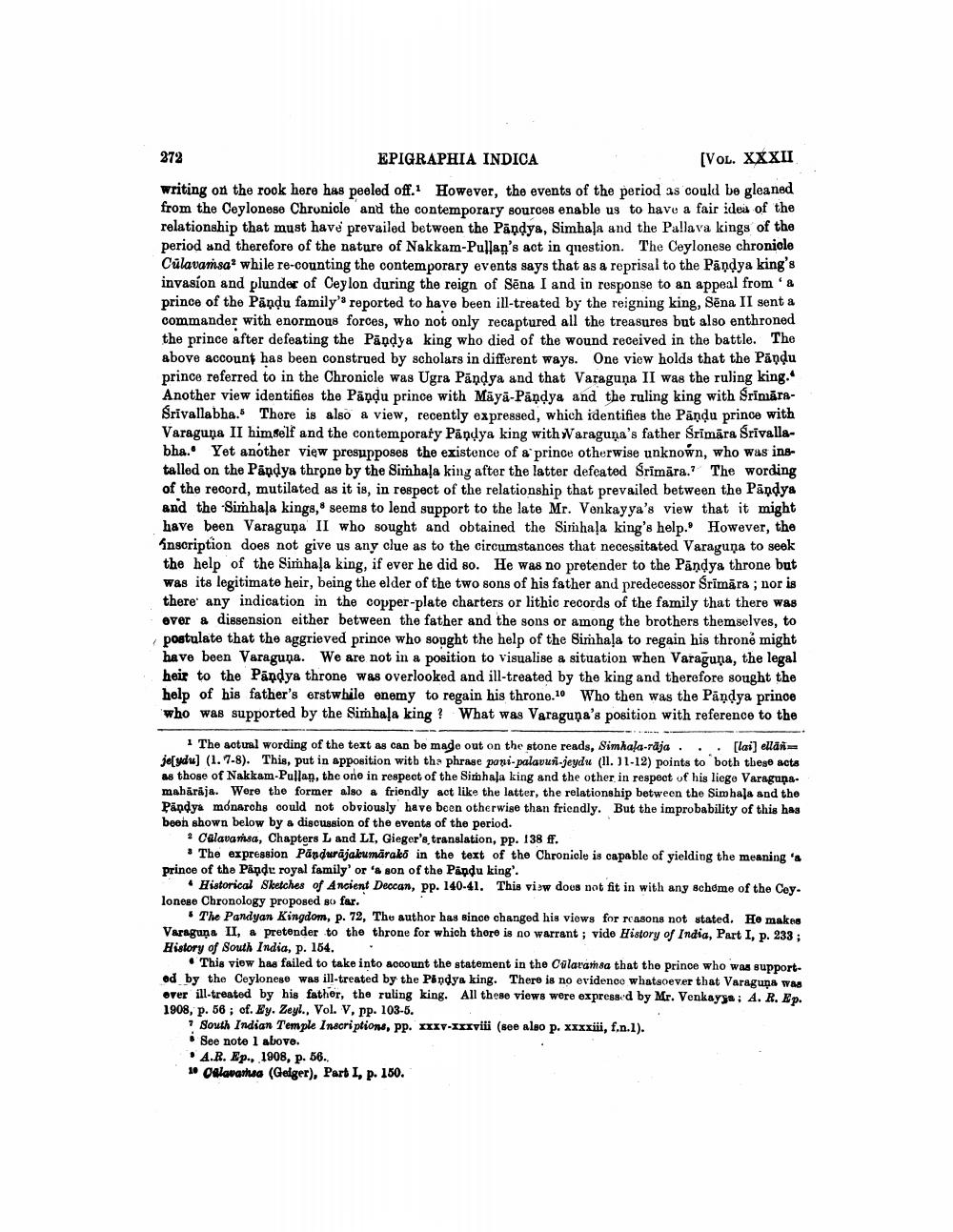________________
272
EPIGRAPHIA INDICA
(VOL. XXXII
writing on the rook here has peeled off. However, the events of the period as could be gleaned from the Ceylonese Chronicle and the contemporary sources enable us to have a fair idea of the relationship that must have prevailed between the Pandya, Simhala and the Pallava kings of the period and therefore of the nature of Nakkam-Pullan's act in question. The Ceylonese chronicle Cúlavamsa? while re-counting the contemporary events says that as a reprisal to the Pandya king's invasion and plunder of Ceylon during the reign of Sēna I and in response to n appeal from '& prince of the Pandu family' reported to have been ill-treated by the reigning king, Sena II sent a commander with enormous forces, who not only recaptured all the treasures but also enthroned the prince after defeating the Pandya king who died of the wound received in the battle. The above account has been construed by scholars in different ways. One view holds that the Pandu prince referred to in the Chronicle was Ugra Pandya and that Varaguna II was the ruling king. Another view identifies the Pāņdu prince with Māya-Pandya and the ruling king with SrimāraSrivallabha. There is also a view, recently expressed, which identifies the Pāndu prince with Varaguna II himself and the contemporary Pāņdya king with Varaguna's father Srimāra Srivallabha.. Yet another view presupposes the existence of a prince otherwise unknown, who was installed on the Pandya throne by the Simhala king after the latter defeated Srimära.? The wording of the record, mutilated as it is, in respect of the relationship that prevailed between the Pandys and the Simhala kings, seems to lend support to the late Mr. Vonkayya's view that it might have been Varaguņa II who sought and obtained the Simhaļa king's help. However, the hnsoription does not give us any clue as to the circumstances that necessitated Varaguņa to seek the help of the Simhaļa king, if ever he did 80. He was no pretender to the Pandya throne but Was its legitimate heir, being the elder of the two sons of his father and predecessor Srimāra ; nor is there any indication in the copper-plate charters or lithic records of the family that there was over & dissension either between the father and the sons or among the brothers themselves, to postulate that the aggrieved prince who sought the help of the Simhaļa to regain his throne might have been Varaguna. We are not in a position to visualise & situation when Varaguna, the legal heir to the Pandya throne was overlooked and ill-treated by the king and therefore sought the help of his father's erstwhile enemy to regain his throne 10 Who then was the Pandya prince who was supported by the Sinhala king? What was Varaguna's position with reference to the
The actual wording of the text as can be made out on the stone reads, Simhala-raja ... [lai] elldijelydu) (1.7-8). This, put in apposition with the phrase pani-palavusi.jeydu (11.11.12) points to both these acts as those of Nakkam-Pullan, the one in respect of the Sinhala king and the other in respect of his liege Varaguņs. maharaja Wore the former also a friendly act like the latter, the relationship between the Simhala and the Påndya monarchs could not obviously have been otherwise than friendly. But the improbability of this has been shown below by a discussion of the events of the period.
* Calavansa, Chapters L and LI, Gieger's, translation, pp. 138 ff.
• The expression Pandurajakumarako in the text of the Chronicle is capable of yielding the meaning ' prince of the Pande royal family' or 's son of the Pandu king'.
Historical Sketches of Ancient Deccan, pp. 140-41. This visw dous not fit in with any scheme of the Cey. lonese Chronology Proposed so far.
. The Pandyan Kingdom, p. 72, The author has since changed his viows for reasons not stated. He makes Varaguna II, a pretender to the throne for which thore is no warrant; vido History of India, Part I, p. 233; History of South India, p. 154. .
This viow has failed to take into account the statement in the Calaramea that the prince who was supportod by the Ceylonese was ill-treated by the Pandya king. There is no evidenco whatsoever that Varagupa was over ill-treated by his fathor, the ruling king. All these views were expressed by Mr. Venkaysa A. R. Kp. 1908, p. 56 ; of. Ey. Zeyl., Vol. V, pp. 103-5.
South Indian Temple Inscriptions, pp. XXXV-Ixxviii (see also p. xxxxiii, f.n.1). . See note 1 above. .A.R. Ep., 1908, p. 56. 1. Ollavansa (Geiger), Part I, p. 150.




